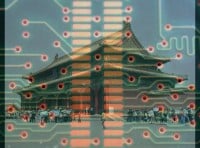
THE CHIPS ARE UP FOR CHINA

Intel moves to India and cuts prices to compete
- Dateline
- 14 August 2012
Who would ever have believed it? China, once the copy-cat nation of the world, has snatched the lucrative computer chip market from Intel with a series of innovative nano-technology breakthroughs.
The first shots were fired in 2008 when China unveiled details of a low-end chip aimed at “bringing personal computing to most ordinary people in China by 2010,” according to Zhiwei Xu, deputy director of the Chinese Academy of Science’s Institute of Computing Technology.
But Beijing quickly raised its sights beyond the local market. More than 1,000 scientists and technicians set to work, and the early chip was soon replaced with a series of high-end nano-chips that have shattered Intel’s near-monopoly with frightening rapidity.
China’s partnership with Swiss company ST Micro, which manufactures the chips under the brand name of Loongson, meaning ‘dragon chip’, gave fast access to international markets. Years of experience and partnerships in the export market paid off.
Most of the leading computer manufacturers have already announced that 2013 models will be shipped with the ‘dragon chip’ instead of Intel’s. “It’s cheaper, faster, nano-sized and more reliable. Case closed,” said a spokesman from Dell.
“This is a classic example of disruption caused by a ‘tsunami of change’,” said FutureWorld guru Neil Jacobsohn. “No industry is safe from disruption, no matter how powerful they may seem to be today. And there’s more to come!”
ANALYSIS >> SYNTHESIS: How this scenario came to be
Although hotly contested by a number of players, the semi-conductor marketplace has been dominated by Intel for some time. The ‘Intel inside’ sound became synonymous with personal computing, and made Intel one of the most powerful brands in the world.
But that all changed in September 2008, with the following announcement, reported by MIT Technology Review:
2 September 2008
Chinese researchers unveil details of a microprocessor that they hope will bring personal computing to most ordinary people in China by 2010. The chip, code-named Godson-3, was developed with government funding by more than 200 researchers at the Chinese Academy of Sciences’ Institute of Computing Technology (ICT).
China is making a late entry into chip making, admits Zhiwei Xu, deputy director of ICT. “Twenty years ago in China, we didn’t support R&D for microprocessors,” he said during a presentation last week at the Hot Chips conference, in Palo Alto. “The decision makers and [Chinese] IT community have come to realize that CPUs [central processing units] are important.”
Tom Halfhill, an analyst at research firm In-Stat, says that the objective for China is to take control of the design and manufacture of vital technology. “Like America wants to be energy independent, China wants to be technology independent,” Halfhill says. “They don’t want to be dependent on outside countries for critical technologies like microprocessors, which are, nowadays, a fundamental commodity.” Federal laws also prohibit the export of state-of-the-art microprocessors from the United States to China, meaning that microchips shipped to China are usually a few generations behind the newest ones in the West.
Despite its late start, China is making rapid progress. The ICT group began designing a single-core CPU in 2001, and by the following year had developed Godson-1, China’s first general-purpose CPU. In 2003, 2004, and 2006, the team introduced ever faster versions of a second chip – Godson-2 – based on the original design. According to Xu, each new chip tripled the performance of the previous one.
Links to related stories
- Gartner warns of slow growth for semiconductor market - Gartner, 31 May 2007
- Chips Go Nano - MIT Technology Review, March 1999
- Intel unveils first Made-in-India chip - The Economic Times, 17 September 2008
- Pentagon Worries About Chinese Chips: By 2014, most chip foundries will be found in Asia - Forbes, 4 September 2008
- MindBullet: FREE COMPUTERS FOR ALL (Dateline: 14 June 2012, Published: 12 August 2004)
- MindBullet: CHINA'S ATTITUDE TO IP BECOMES WORLD NORM (Dateline: 12 September 2015, Published: 01 December 2005)
- MindBullet: SILICON OUSTED BY PLASTIC (Dateline: 19 August 2015, Published: 07 August 2008)
Warning: Hazardous thinking at work
Despite appearances to the contrary, Futureworld cannot and does not predict the future. Our Mindbullets scenarios are fictitious and designed purely to explore possible futures, challenge and stimulate strategic thinking. Use these at your own risk. Any reference to actual people, entities or events is entirely allegorical. Copyright Futureworld International Limited. Reproduction or distribution permitted only with recognition of Copyright and the inclusion of this disclaimer.